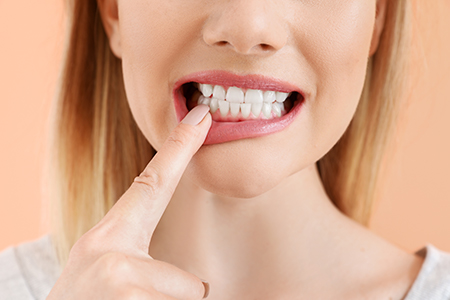
Our Office
8-10 Saddle River Road
Fair Lawn, NJ 07410
Existing Patients: (201) 797-8711
New Patients: (201) 479-0901
Visit Us Online

Gum disease is far more common than most people realize — studies from national health authorities show that roughly half of adults over 30 show signs of periodontal disease. The condition ranges from mild inflammation to advanced tissue and bone loss, and it’s the leading cause of adult tooth loss. At Stahl Dental Studio, we focus on preventing progression, restoring periodontal health when possible, and helping patients keep a predictable, comfortable smile for years to come.
Periodontal disease starts quietly: bacteria in dental plaque collect along the gumline and produce toxins that irritate and inflame the surrounding tissues. Left unchecked, this inflammation creates pockets between the teeth and gums where debris and bacteria can accumulate more easily, driving a cycle of worsening infection and tissue breakdown.
In the earliest phase, inflammation is usually reversible with focused oral hygiene and professional cleaning. Once the infection advances, however, it can damage the connective tissues and underlying bone that support teeth. That’s why recognizing problems early and addressing them promptly are central to preserving long-term oral function.
Regular dental checkups reveal subtle changes long before symptoms become severe. During exams we measure pocket depth, assess tissue health, and track bone levels using clinical and radiographic tools. Those baseline data guide targeted treatment plans designed to stop disease activity and restore a healthy environment around the teeth.
Gum disease does not always cause obvious pain, so understanding common warning signs is useful. Symptoms can appear gradually or intermittently, and some signs are easy to miss without a professional exam. Paying attention to changes helps patients get timely care.
Signs you should not ignore include:
Red, swollen, or tender gums
Bleeding during brushing or flossing
Gum recession or exposed root surfaces
Increased tooth sensitivity or persistent bad breath
Loose teeth, shifting contacts, or changes in how a bite feels
Not all signs occur in every case, and some conditions may mimic gum disease. A professional evaluation allows us to determine the cause and recommend the most effective next steps.

The earliest stage of gum disease — often referred to as gingivitis — is principally an inflammatory response to plaque and can usually be reversed. Improvements at home combined with professional care typically restore healthy gum tissue and resolve bleeding and swelling when the condition is addressed promptly.
Effective early care emphasizes meticulous plaque control: consistent twice-daily brushing, daily interdental cleaning, and professional hygiene visits. During an office visit we remove hardened deposits above and below the gumline that your toothbrush cannot reach, then recommend a personalized home-care approach to prevent recurrence.
If early measures do not fully resolve the inflammation, adjunctive therapies such as localized antimicrobial agents may be recommended to reduce the bacterial load. When patients commit to follow-up care and maintenance, the prospects for halting disease at this stage are excellent.

When inflammation progresses to periodontitis, the supporting structures around teeth — connective tissue and bone — begin to break down. Clinically, this shows up as deeper periodontal pockets, gum recession, and measurable bone loss. At this stage, treatment shifts from purely preventative to therapeutic, with the goal of controlling infection and preserving as much natural support as possible.
A comprehensive treatment plan is tailored to the individual and may combine non-surgical care, localized medication, or surgical approaches depending on pocket depth, bone levels, and overall health. The primary clinical objectives are to eliminate pathogenic bacteria, reduce pocket depth, and create an environment that patients can successfully maintain at home.
Advanced management can also include regenerative strategies where appropriate — procedures designed to encourage the body to rebuild lost tissue or bone and to improve the long‑term stability and appearance of the smile.

For many patients, non-surgical therapy is the first line of defense. This includes deep cleaning procedures to remove plaque and tartar beneath the gumline, smoothing root surfaces to discourage future buildup, and reinforcing effective home care. These steps reduce inflammation and often restore periodontal stability when disease is detected early.
We rely on evidence-based protocols and minimally invasive options whenever they can achieve a satisfactory outcome. Local antimicrobial therapies or short courses of systemic medications may be used selectively to support mechanical cleaning when deeper pockets are present.
Following initial therapy, a structured maintenance schedule is essential. Regular periodontal maintenance visits allow us to monitor tissue response, remove any new deposits, and adjust the plan to prevent relapse.
If non-surgical care does not yield the needed improvement, the next step may involve surgical techniques aimed at improved access and regeneration.
Surgery is considered when pocket depths exceed the reach of non-surgical instruments or when there is significant tissue or bone loss. Surgical procedures allow direct access to root surfaces for thorough cleaning, enable reshaping of defective bone, and permit placement of grafts or membranes to support tissue regeneration.
Having surgical options increases the ability to arrest disease progression and, in many cases, to rebuild the support that has been lost. Modern techniques — including the selective use of lasers in appropriate cases — can reduce morbidity and improve healing.
The overarching aims of surgical therapy are straightforward:
Remove pathogenic bacteria and deposits from below the gumline
Protect and, where possible, restore supporting bone and soft tissue
Reduce pocket depth to make daily home care and professional maintenance more effective
When surgery is recommended, we discuss the expected benefits, recovery process, and follow-up schedule so patients understand the path forward and can make informed decisions.
Successful periodontal care doesn’t end when active therapy is complete. Long-term stability depends on a disciplined maintenance program, regular periodontal assessments, and a partnership between patient and clinician. Maintenance visits typically include targeted cleaning, re-evaluation of pocket depths, and reinforcement of home-care techniques.
We also consider each patient’s overall health: systemic conditions such as diabetes, certain medications, and lifestyle factors like tobacco use can influence outcomes. When appropriate, we coordinate care with medical providers to address underlying contributors and improve periodontal prognosis.
For patients considering restorative or implant options, addressing periodontal stability first is critical. A healthy foundation maximizes the longevity and function of crowns, bridges, and implants, and it improves cosmetic results as well.
Open communication is a priority: we outline realistic expectations, milestones for healing, and practical steps patients can take to protect their investment in oral health.
In summary, periodontal disease ranges from reversible inflammation to advanced tissue loss, and timely, tailored care is essential to preserve teeth and overall health. Stahl Dental Studio provides thorough diagnostic assessments, evidence-based therapies, and long-term maintenance plans to help patients protect their smiles. If you would like more information about periodontal care or how we can help you maintain healthy gums, please contact us for additional details.
Periodontal disease is caused by the accumulation of bacterial plaque and hardened tartar along and beneath the gumline, which triggers an inflammatory response in the surrounding tissues. When bacteria persist in these areas they produce toxins that irritate the gums and can damage the connective tissues and bone that support the teeth. Early-stage disease may be managed more easily, but untreated bacterial inflammation drives progression to more destructive forms of gum disease.
Clinicians at the office of Stahl Dental Studio emphasize that several factors increase susceptibility to periodontal disease, including tobacco use, uncontrolled diabetes, certain medications that reduce saliva flow, and genetic predisposition. Poor oral hygiene and infrequent professional cleanings also raise risk by allowing plaque to mature and harden into tartar. Addressing modifiable risk factors alongside professional care helps reduce the bacterial burden and slow disease development.
Early signs of gum disease commonly include gums that appear red, swollen, or tender, and bleeding during brushing or flossing. Persistent bad breath or a lingering bad taste in the mouth can also indicate an ongoing bacterial problem in the periodontal tissues. Because early-stage disease can be painless, noticing these subtle changes and seeking evaluation is important for timely care.
As disease progresses you may observe gum recession, increased tooth sensitivity, or teeth that feel looser than before, and these signs warrant prompt attention. Regular dental exams allow your provider to detect early changes that may not be obvious at home. Timely intervention often prevents further tissue and bone loss and preserves long-term oral health.
Gingivitis is the initial, reversible stage of gum disease characterized by inflammation confined to the gum tissue without loss of the supporting bone or connective tissue. With proper professional care and improved home hygiene, gingivitis typically resolves and tissue health can be restored. Gingivitis serves as a warning sign that plaque control needs to be addressed to prevent progression.
Periodontitis occurs when inflammation extends below the gumline and begins to destroy the connective tissues and underlying bone that secure teeth in place, creating periodontal pockets. This stage is associated with irreversible tissue loss and requires targeted periodontal therapy to halt progression and attempt to restore support where possible. Early detection while disease is still gingivitis provides the best opportunity to avoid the more complex treatments needed for periodontitis.
Diagnosis begins with a thorough clinical examination that includes measuring periodontal pocket depths, assessing gum inflammation, and checking for tooth mobility or recession. Dental radiographs are used to evaluate bone levels around the teeth and to identify areas of bone loss that are not visible during the clinical exam. Your dentist or hygienist will also review your medical and dental history to identify systemic risk factors that can influence periodontal health.
Periodontal charting and documentation are important for establishing a baseline and tracking disease activity over time, and this information guides treatment planning. In some cases, additional tests such as microbial sampling or assessment of inflammatory markers may be considered to refine care. Together, clinical findings and diagnostic imaging inform a personalized approach to controlling disease and maintaining long-term periodontal stability.
The foundational non-surgical treatment for periodontal disease is scaling and root planing, a deep cleaning procedure that removes plaque and tartar from below the gumline and smooths root surfaces to discourage bacterial reattachment. Adjunctive therapies can include locally delivered antimicrobials placed into periodontal pockets and short courses of systemic antibiotics when indicated by the severity of infection. Patient education and reinforcement of daily oral hygiene practices are essential components of non-surgical care to reduce bacterial load and inflammation.
After initial therapy, a structured maintenance program of professional cleanings and periodic re-evaluation helps monitor healing and detect any signs of recurrence early. In some cases, minimally invasive laser therapy or subgingival irrigation therapies may be offered as adjuncts to improve pocket reduction. If non-surgical measures do not control disease, the dental team will discuss surgical options designed to further reduce pocket depth and restore tissue health.
Periodontal surgery is typically recommended when deep periodontal pockets (commonly 5 mm or greater), progressive attachment or bone loss, or persistent infection cannot be adequately managed with non-surgical therapy. The goal of surgical treatment is to gain access for thorough cleaning of root surfaces, reduce pocket depth, and reshape or regenerate lost tissue to improve long-term maintenance. Flap surgery, or pocket reduction procedures, involve temporarily reflecting the gum tissue to remove bacteria and diseased tissue and then repositioning the gums for improved healing and accessibility.
Other surgical approaches may include regenerative procedures to rebuild lost bone and connective tissue, soft tissue grafts to address recession, or recontouring of the bone to create a more maintainable periodontal architecture. Advances such as laser-assisted periodontal therapy can be used selectively to reduce bacterial load and assist healing, though their applicability depends on the clinical situation. Postoperative maintenance and rigorous oral hygiene remain critical to protect surgical outcomes and minimize recurrence.
Bone grafts and regenerative therapies are used to restore lost bone and supporting structures that result from advanced periodontal disease, with the aim of improving tooth stability and creating a foundation for better long-term function. Grafting materials can be autografts, allografts, xenografts, or synthetic substitutes, and they are often used in combination with barrier membranes or biologic growth factors to encourage new bone and connective tissue formation. These procedures are carefully selected based on defect size, location, and the patient’s overall health.
Successful regenerative treatment can reduce pocket depth, enhance support around affected teeth, and in some cases create sufficient bone volume to support future restorative options such as dental implants. Healing times vary, and follow-up care includes monitoring, professional cleanings, and a strict home care regimen to protect the regenerating tissues. Realistic expectations, careful surgical technique, and consistent maintenance are key to achieving favorable regenerative outcomes.
Yes, effective periodontal treatment is an important step when dental implants are being considered, because implants require a healthy, infection-free environment and adequate bone and soft tissue support for predictable long-term success. Controlling active periodontal disease through non-surgical or surgical therapy, and restoring lost bone when needed with grafting procedures, helps establish the stable foundation that implants depend on. Placing implants into tissue that is still inflamed or infected increases the risk of complications and implant failure.
Once periodontal health is achieved and maintained, clinicians can evaluate bone volume and soft tissue conditions to determine implant feasibility and timing. In some cases, regenerative therapies performed during periodontal treatment can simultaneously prepare the site for later implant placement. A coordinated treatment plan between the periodontal and restorative team ensures the best possible functional and aesthetic outcomes for implant-supported restorations.
Prevention centers on consistent, effective oral hygiene practices that remove plaque daily, including twice-daily toothbrushing with a fluoride toothpaste and interdental cleaning using floss or an appropriate interdental device. Regular professional care with dental examinations and periodontal assessments, along with routine cleanings, allows early identification and management of gingivitis before it advances. Lifestyle factors such as avoiding tobacco, managing diabetes, and maintaining a balanced diet also support periodontal health and reduce inflammation.
Personalized maintenance plans that reflect individual risk factors and disease history are essential for long-term prevention, and these plans typically include more frequent professional cleanings for patients with a history of periodontal disease. Patient education, motivation, and periodic reassessment help ensure that home care remains effective and that any recurrence is caught early. Collaboration between the patient and dental team is the most reliable strategy for preserving healthy gums and teeth over time.
Stahl Dental Studio provides comprehensive periodontal assessment and treatment that integrates current diagnostic methods, evidence-based therapies, and personalized maintenance planning to address a wide range of gum health needs. Their clinical team applies both non-surgical and surgical approaches, including regenerative techniques and adjunctive therapies, to control disease, restore function, and support long-term oral health. Care decisions are based on a thorough evaluation of periodontal status, medical history, and patient goals to ensure appropriate and effective treatment pathways.
Patients benefit from a coordinated approach that emphasizes prevention, early intervention, and ongoing maintenance to preserve results after active therapy. Clear communication about diagnosis, treatment options, expected healing, and home care helps patients take an active role in protecting their periodontal health. Regular follow-up and individualized recall schedules are used to monitor stability and reduce the likelihood of disease recurrence.
